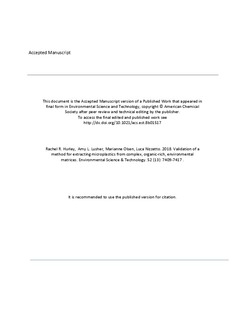| dc.contributor.author | Hurley, Rachel R | |
| dc.contributor.author | Lusher, Amy L | |
| dc.contributor.author | Olsen, Marianne | |
| dc.contributor.author | Nizzetto, Luca | |
| dc.date.accessioned | 2019-10-11T14:48:40Z | |
| dc.date.available | 2019-10-11T14:48:40Z | |
| dc.date.created | 2018-09-27T10:40:20Z | |
| dc.date.issued | 2018 | |
| dc.identifier.citation | Environmental Science and Technology. 2018, 52 (13), 7409-7417. | nb_NO |
| dc.identifier.issn | 0013-936X | |
| dc.identifier.uri | http://hdl.handle.net/11250/2621703 | |
| dc.description.abstract | Complex and organic-rich solid substrates such as sludge and soil have been shown to be contaminated by microplastics; however, methods for extracting plastic particles have not yet been systemically tested or standardized. This study investigated four main protocols for the removal of organic material during analysis of microplastics from complex solid matrices: oxidation using H2O2, Fenton’s reagent, and alkaline digestion with NaOH and KOH. Eight common polymer types were used to assess the influence of reagent exposure on particle integrity. Organic matter removal efficiencies were established for test sludge and soil samples. Fenton’s reagent was identified as the optimum protocol. All other methods showed signs of particle degradation or resulted in an insufficient reduction in organic matter content. A further validation procedure revealed high microplastic extraction efficiencies for particles with different morphologies. This confirmed the suitability of Fenton’s reagent for use in conjunction with density separation for extracting microplastics. This approach affords greater comparability with existing studies that utilize a density-based technique. Recommendations for further method optimization were also identified to improve the recovery of microplastic from complex, organic-rich environmental samples. | nb_NO |
| dc.language.iso | eng | nb_NO |
| dc.publisher | American Chemical Society | nb_NO |
| dc.title | Validation of a Method for Extracting Microplastics from Complex, Organic-Rich, Environmental Matrices | nb_NO |
| dc.type | Journal article | nb_NO |
| dc.type | Peer reviewed | nb_NO |
| dc.description.version | acceptedVersion | nb_NO |
| dc.source.pagenumber | 7409-7417 | nb_NO |
| dc.source.volume | 52 | nb_NO |
| dc.source.journal | Environmental Science and Technology | nb_NO |
| dc.source.issue | 13 | nb_NO |
| dc.identifier.doi | 10.1021/acs.est.8b01517 | |
| dc.identifier.cristin | 1614561 | |
| dc.relation.project | Norges forskningsråd: 271825 | nb_NO |
| dc.relation.project | Norges forskningsråd: 257434 | nb_NO |
| cristin.unitcode | 7464,30,21,0 | |
| cristin.unitcode | 7464,20,19,0 | |
| cristin.unitname | Miljøkjemi | |
| cristin.unitname | Miljøgifter | |
| cristin.ispublished | true | |
| cristin.fulltext | postprint | |
| cristin.qualitycode | 2 | |
